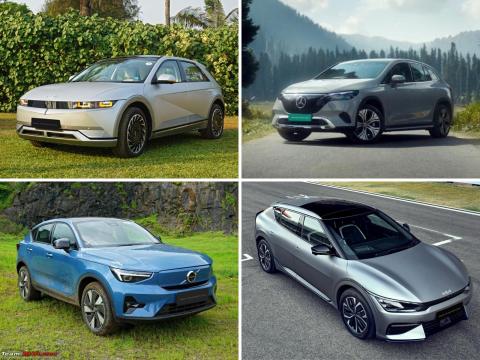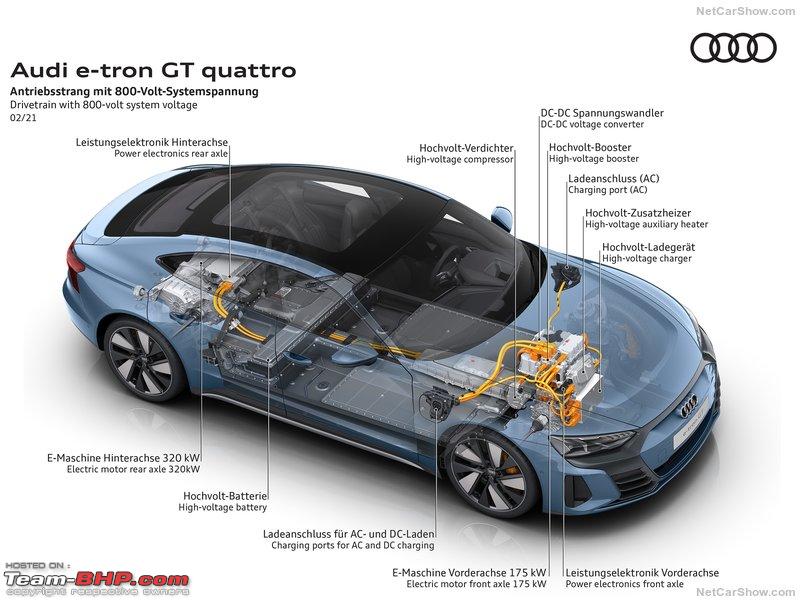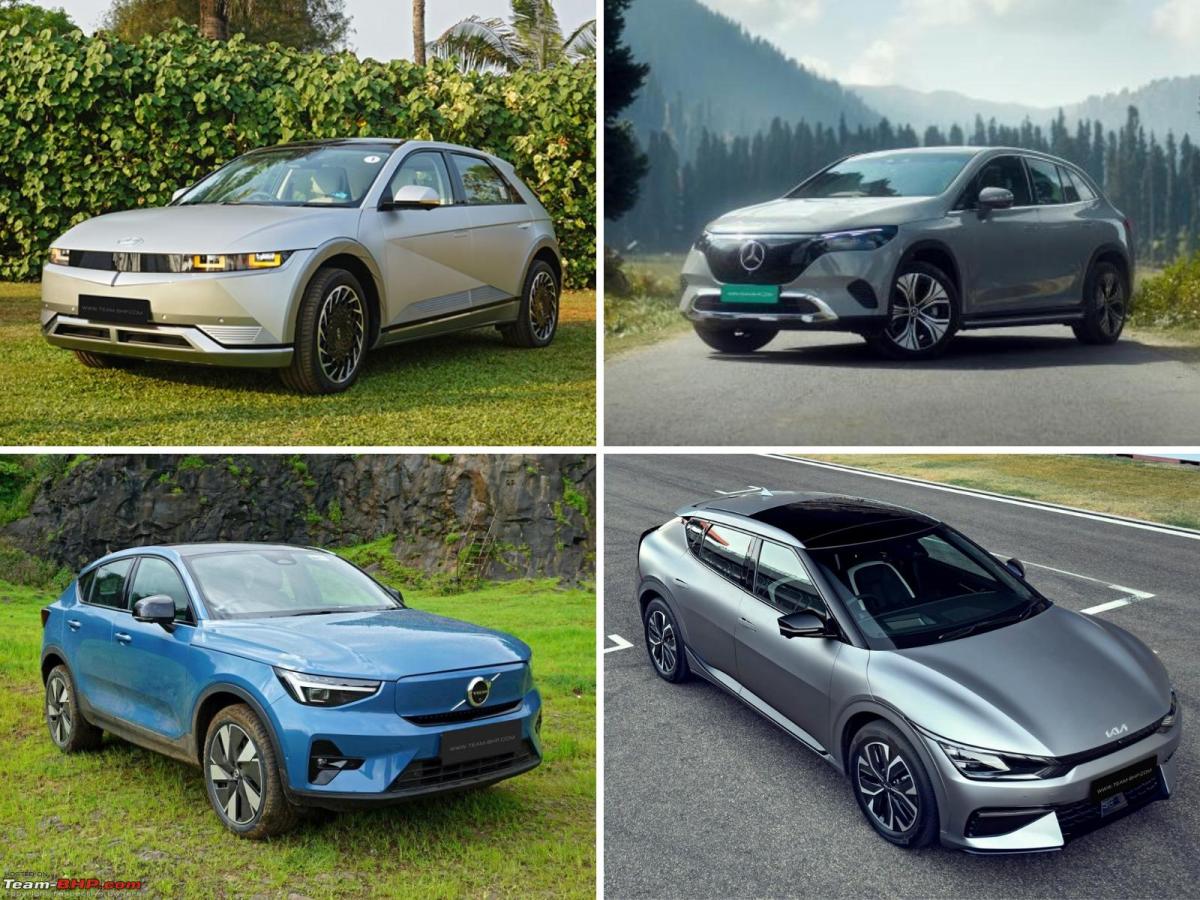Some of the cars that use the 800V system are the Audi E-Tron GT, Kia EV6, and Hyundai Ioniq 5.
BHPian Omkar recently shared this with other enthusiasts.
Times are changing fast and we’re surrounded by more electric vehicles than we would’ve expected a few years ago. While we know most things about IC engine cars – how they work, what systems are involved, the standard set of do’s and don’ts etc., we tend to overlook a lot of similar things in electric vehicles probably because they’re pretty straightforward to drive. However, IMO, EVs are far from that. There’s a lot of technology involved and the level of complexity is also high. With such an influx of EVs in our market, it’s about time we also got ourselves acquainted with the technology to make better decisions. To be specific, I am referring to electric vehicle architecture.
Before we get to the specifics of the architecture, quoting the basics of an electric vehicle from one of our official reviews:
There are 3 main components in an EV – the battery, the motor and the controller/charger. The battery is what stores the energy and the motor is what uses that energy to drive the wheels of the car. The controller/charger converts the energy from the battery into a usable form to power the motor. In more technical terms, the power grid from your house or a charging station is usually an AC. The lithium-ion battery can store electric energy in DC form. So while charging, there’s usually an AC/DC converter that will convert the power grid’s AC into DC and store it in the car’s battery. The DC fast chargers that you see, usually have the AC/DC converter inbuilt, which is how they can charge the car’s battery faster. The controller typically sits on top of the motor.
Now coming to the electric vehicle architecture, if you have been following the news, you might have noticed that some of the manufacturers are now opting for an 800V battery architecture. This is obviously in the premium EV segment, not the budget segment, but some manufacturers have made the change. Most of our budget EVs come with a 400V battery architecture. Let’s take two Hyundai EVs for example – the Kona EV and the Ioniq 5. Just look at some of the stats below and something seems a bit odd. How does the Ioniq 5 manage to charge in a similar time as the Kona while having a battery that’s almost twice as big? The simple answer is that the Ioniq 5 has better EV tech, which is what we’ll dive deep into. The Kona EV has a 400V architecture while the Ioniq 5 has an 800V architecture.
Tech talk
To understand how voltage works and how it affects the charging time and even the way an EV drives, let’s jump into some technical details. I’m sure there are quite a few members on the forum who’ve worked closely with EVs and will be able to shed more light on the same. As is with some electrical engineering concepts, you can use the hydraulic loop analogy to understand the concept better. There’s a reservoir, a motor/pump and pipes. The voltage is equivalent to the pressure in the pipes. So, if you use a more powerful motor/pump or a larger reservoir, the pressure in the pipes will increase. Remember Ohm’s law?
Voltage = Current x Resistance
The current would be the diameter of the pipes. Hence if you increase the diameter (i.e. current) the pressure will drop (i.e. voltage). Manufacturers try to keep the resistance minimum hence they must play around with the other two factors that are inversely proportional to each other.
So, what does all this mean in EV terms? A higher voltage architecture will need less current to push the same amount of power to the motor. How does that help? Lower current means manufacturers can use lighter wiring harnesses. Also, current is one of the primary reasons for heat generation in electronics. Low current means less heat generation, ergo longer lifespan for electronics and batteries. Also, heat generation during fast charging is usually the limiting factor for charging speed. Putting it all together, high voltage, low current and less heat means that the charging speed can be much higher. Circling back to the Kona vs Ioniq 5 example, the 800V architecture in the Ioniq 5 allows it to charge faster. More importantly, it also allows the Ioniq 5 to use fast charging options like the 150kW charger that can charge the battery from 10-80% in ~ 25 mins or even the 250kW fast charging that can charge the battery from 10-80% in ~ 18 mins. In comparison, the Kona EV can only go up to 100kW charging that will charge the battery (10-80%) in ~48 mins.
Additional benefits of high voltage architecture
As mentioned earlier, the high voltage architecture means lesser wiring, reducing the complexity of the system. Lower heat generation means that the loss of power due to overheating is almost eliminated. The system is more efficient in terms of power delivery. You don’t have to worry about your system being overworked. Even if you’re doing back-to-back drag races, or pushing the car for a long period, the system won’t overheat easily and the battery drop won’t be drastic. Think of this as redlining your IC engine car. You cannot over-rev the engine for a long period as that will strain it and probably blow it up if you overdo things. But with a high-voltage architecture, you can get the maximum rated power output over and over again without putting the system under immense pressure.
What’s the current scenario?
It was Porsche who first brought the 800V architecture to its road cars with the Taycan. They had used the tech earlier in their Le Mans-winning 919 Hybrid race car. Some of the cars that use the 800V system are the Audi E-Tron GT, Kia EV6, and Hyundai Ioniq 5. The Mercedes EVs like the EQS sedan and the EQE SUV are currently using the 400V system but are rumoured to be receiving the 800V system soon. Most of the other EVs are still using the 400V system, but as time goes by, they might also consider shifting to the 800V system.
How does it matter?
Some of you might be thinking, “Long wait times don’t bother me as much. Why should I spend the extra amount? How does any of this matter?” That’s totally fine as well. High voltage architecture like the 800V system is more efficient and doesn’t face overheating issues. Along with the temperature management systems in place, you have EVs with longer life. For someone who’s in the market for an EV and who likes to keep their cars for a long period, investing an additional amount initially makes more sense than having an outdated car 3-4 years down the line. Because as it seems, manufacturers will start offering 800V systems soon enough. The Ioniq 5 is the most affordable car with the 800V system and in the coming years, technology will become more accessible and affordable.
People used to say that EVs are the future. Well, the future is here, so why not prepare for the future that is to come? Do share your thoughts on the same.
Sources – 1, 2, 3
Here’s what BHPian DIY410 had to say on the matter:
No Indian manufacturers do not struggle, the criteria for automotive wires are the insulation rating, designed to handle the high ambient temperature of the engine bay area which is much higher than the EV powertrain area, vibrations and flexibility. So the material used is different then the household wires.
Even your basic no-name cheap household wire will have an insulation voltage rating printed on it, which is typically 600v for the basic ones, irrespective of the current they pull.
Finolex, Polycab etc even their basic household wire have a rating of 1100v, irrespective of the current draw.
Your spark plug wire insulation is rated to handle 40000v.
So if you use a basic Finolex household 1100v wire of 2.5sq.mm rated at 18A, it can in theory pull close to 20kw of power(V*I) before its insulation starts to fail under standard test conditions.
But the same wire if used in a 12v DC of a vehicle, can pull only around 220 watts. So that is why Elon Musk is switching to 48v, which can also result in switching to aluminium core wires instead of expensive copper.
The same applies to HV cables.
Indian manufacturers even export automotive wires to Russia besides other nations.
Here’s what BHPian DIY410 had to say on the matter:
HV harness means a bunch of HV cables in a wire loom with connectors. Anyone can make a harness. Substitute the HV cables with automotive-grade HV cables you get an HV harness for automotive use.
There are plenty of harness makers in India, who buy automotive-grade wire from Indian manufacturers.
If Indian manufacturers can supply for the extremely harsh operating environment of defence applications from aircraft, missiles, and submarines. An EV HV wire is the most basic of the basic, a welding cable handles 400A DC or more and it’s available on the shelf in India from any big wire company.
The same goes for DC solar panel wires which are exposed to 8 hours of sunlight UV rays etc and the operating voltage rating is 400v to 1000v for rooftop applications.
It’s all in the material of the insulations that determines the application from Temperature, Current, Voltage, Flexibility, Abrasion Resistance, UV, Gases etc.
Here’s what BHPian Jeroen had to say on the matter:
Thanks for putting up this thread. I see some comments about wiring harnesses and so on. I would say that on all ICE cars, one of their weak points is ultimately the quality of all the wiring used. As cars age, the wiring does degrade. Or rather in most cases the insulation. Which becomes brittle, starts to crack and so on. On cars over say 20 years old this is very often a problem, it’s not the car electronics, more often it is the wiring and wiring components such as connectors that are becoming problematic.
Time will tell how EVs which rely even more on wiring in various shapes and formats will stand the test of time. Already we know that battery aging is not an issue. But it will be a couple of decades before wiring issues show up.
And trust me, some of the big A brands have had horrible wiring issues that are rearing their ugly head now after 20-30 years. E.g. most Jaguars, quite a few Range Rovers, and also certain types of BMW and Audi.
My Jaguar X308 is famous for its low-quality wiring installed. Won’t give you any problem for the first 15-20 years, but plenty later on in life.
Ageing is a real issue on all wiring and cables. Time will tell who got the quality wiring and cables installed.
Check out BHPian comments for more insights and information.
Source: Read Full Article






